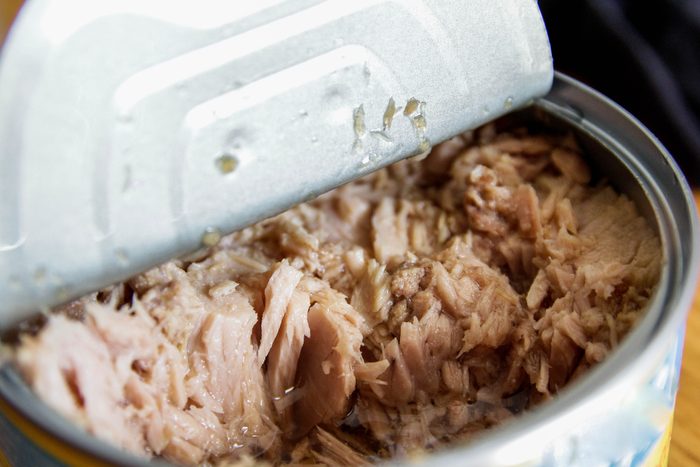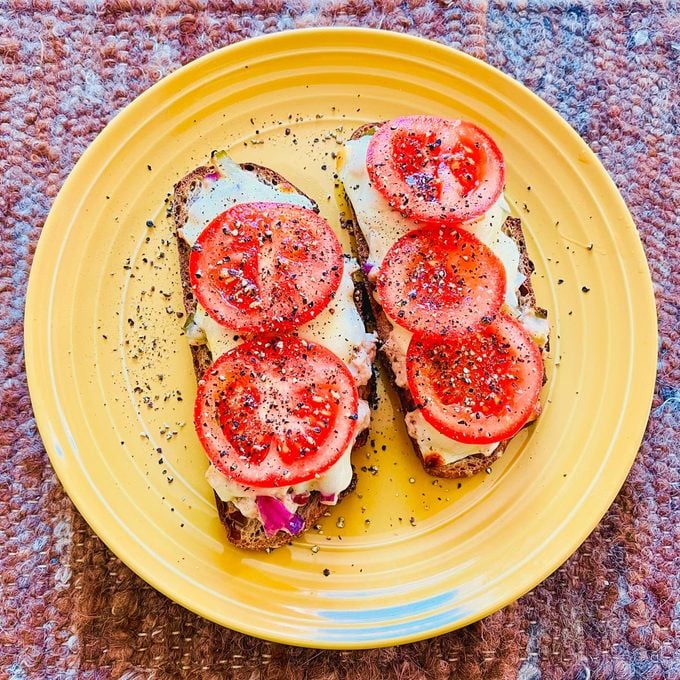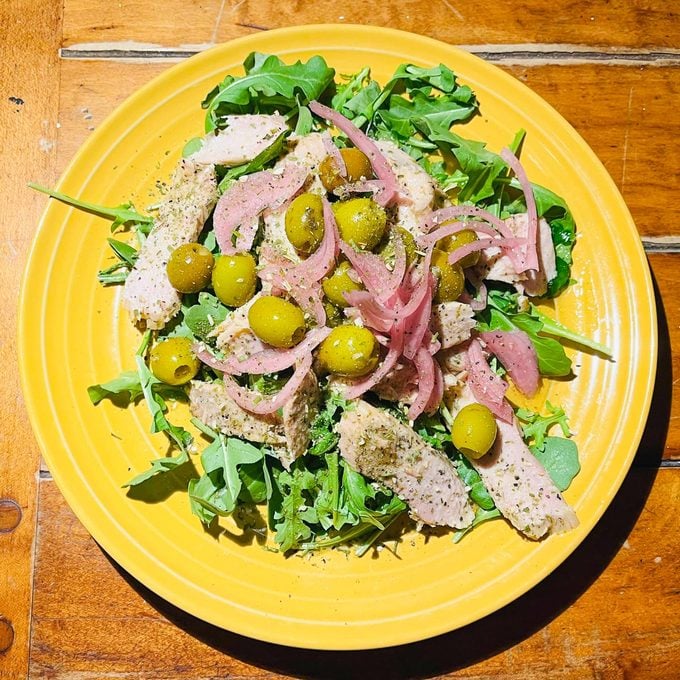I Ate Tuna Every Day for a Week—Here’s What Happened
Updated: Dec. 21, 2022

You'll be craving tuna salad when you read about this writer's daring nutrition experiment.
Tuna is fished in over 70 countries, and canned tuna is one of the most universally consumed foods, according to Colorado State University in collaboration with the Colorado Department of Public Health and Environment.
This isn’t surprising, as canned tuna is a nutrient-dense food and a good source of protein, omega-3 fatty acids, vitamin D, and selenium. Those omega-3 fatty acids are critical for healthy brain function, as well as reducing inflammation and supporting cardiovascular health. Vitamin D helps maintain levels of phosphorus and calcium, which contributes to bone health and preventing osteoporosis. Selenium plays an important role in thyroid and hormone function.
According to Smithsonian, tuna salad sandwiches originated in the 19th Century as a way to avoid wasting food. “Scraps of chicken, ham or fish from supper would be mixed with mayonnaise and served on lettuce for lunch,” their report reads. “Leftovers of celery, pickles and olives—served as supper ‘relishes’—would also be folded into the mix.”
These days, many Americans stash cans of tuna in their cupboards because it’s a shelf-stable food that can quickly be turned into a nutritious lunch or dinner, and there are a lot of things you can do with it beyond tuna salad. Take the tuna melt—tuna salad’s warm, comfort-food cousin—because what isn’t better with melted cheese on top?
I grew up eating tuna fish and have memories of sitting at the Woolworth’s counter with Mimi, my Depression-era grandmother, eating tuna on rye toast with extra pickles. Tuna is ingrained in my childhood culinary memories, as Mimi and her sisters loved to whip up a batch for us after we’d spent a morning at the beach. I’d slide a few chips into the sandwich for extra crunch, and it always hit the spot.
My college advisor also used to host a weekly dinner for a small group of us students, and I learned from her that there are plenty of hot tuna dishes for dinner beyond tuna casserole. This grilled tuna dish from our sibling site, Taste of Home, is one example.
I recently decided to eat tuna fish every day for a week, experimenting with this superfood in new and old ways. Here’s what I discovered.
I Had Salmon Every Day for a Week—Here’s What Happened
A healthy tuna salad sandwich
I started my week of eating tuna with the basics: Chicken of the Sea in Water. Many nutritionists recommend tuna packed in oil, though tuna canned in water still delivers protein and other health benefits. What I love about Chicken of the Sea’s tuna is it’s nearly shredded in the can, making it perfect for tuna salad sandwiches. I mixed two cans with with Hellman’s Real Mayonnaise (also a good source of omega-3s) with chopped celery and diced purple onion. Some people like to mix in relish or cut up dill pickles, but I prefer slices of pickle on top. (Avocado oil mayo is an option, but I’m committed to the mayo of my childhood.)

The first day I had tuna salad on rye sourdough toast. From there, I had enough leftovers to have a snack on crackers—each one topped with a bread-and-butter pickle—and for two rounds of tuna melts.
6 Health Reasons You Need to Be Drinking Pickle Juice
Going beyond sandwiches
Next, I went for the olive oil-packed tuna with Tonnino Ventresco wild-caught yellowfin tuna in olive oil. I liked it even before I opened the jar: the filets are nestled upright and look like a true delicacy. Plus, you can visit the brand’s website to trace your tuna if you like knowing exactly where your food comes from.
As much as I love mayo, Tonnino’s yellowfin isn’t the kind of tuna you chop up into a salad, but rather something you use, as I did, to make my variation on a non-traditional Nicoise salad, which included arugula, the yellowfin filets, pickled onion, and Musco Family garlic-stuffed queen olives from Greece. I dressed my salad with olive oil, Sicilian-lemon-infused white balsamic vinegar, fresh cracked pepper and sea salt flakes. This salad was so incredible I made the same exact thing the next day.

Eating tuna every day for a week was easy.
One day while I was out running errands, I stopped into a local shop for an ahi tuna poke bowl. Another night when I didn’t feel like cooking, I picked up some spicy tuna rolls. Inspired by a friend who’s a chef, I made a dish similar to one she fell in love with when studying abroad in Italy: sautéed garlic, just-wilted spinach, tuna filets on top. Honestly, it doesn’t get much tastier—not to mention the impressive nutrition density.
The holiday season can run us ragged, and one night I found myself home with snow on the way. A quick peer through the cupboards showed I had what I needed to make spaghetti with tuna and capers. To make classic spaghetti healthier, our senior editor loves Banza chickpea pasta—a generous source of plant-based protein and complex carbohydrates, including plenty of fiber.
At another point during the week, I was heading out for a run on a chilly day and simply didn’t want to get hungry out there. For something quick, easy, and healthy, I opened a can of Scout smoked wild albacore tuna and ate it straight out of the can. I found that it sustained me on my run. Tuna can do that, even as a solo player.
The 7 Best Fish to Eat—and 5 to Never Eat
How healthy is tuna?
Many people worry about the mercury content in tuna (and other fish), and for good reason. I connected with Dr. Kelly Johnson-Arbor, MD, medical toxicologist, co-medical director, and interim executive director at the National Capital Poison Center, for more information on the risks and rewards of tuna. “While most people can eat fish on a regular basis as part of a healthy diet, some individuals may want to limit the amount and type of fish that they consume,” she says. “Mercury is a heavy metal that is present in some types of fish.”
Dr. Johnson-Arbor explained that while there is no evidence the mercury contained in fish is damaging to the adult brain, mercury can cause harmful effects on the developing brain. This is why the EPA and FDA recommend that infants, children, pregnant or breastfeeding women and women who intend to become pregnant limit their consumption of certain types of fish, including some tuna species.
Both canned and fresh tuna can contain mercury, yet this fish still recommended because it’s such a good source of protein and fatty acids. Chunk light tuna contains less mercury than chunk white. “Remember that one serving of fish is approximately the size of the palm of your hand,” Dr. Johnson-Arbor says. “Eating two to three servings of low-mercury fish each week is a good way to supplement a healthy diet for most people!” (At The Healthy @Reader’s Digest, to lessen the chances of mercury consumption, we’re fans of the tuna from Wild Planet Foods, a company that “catches younger, smaller, migratory tuna near the surface rather than older and larger tuna that have accumulated more mercury,” according to what a brand representative tells us.)
I asked Dr. Johnson-Arbor if there were any risk to my eating tuna every day for a week. She ensured me there wasn’t—that my body would eliminate the excess mercury within a few weeks. I certainly felt none of the signs of mercury poisoning, which include tremors, headache, irritability, personality changes, and skin rashes. Dr. Johnson-Arbor reminds us that Poison Control is available online at www.poison.org or by phone at 1-800-222-1222, and both options are free, confidential, and available 24 hours a day.
I won’t keep eating tuna every day, but I believe in this powerful superfood and will continue to incorporate it into my diet, whether that is on a to-die-for salad, straight out of the jar or can, or as the main star in a tuna melt.




















